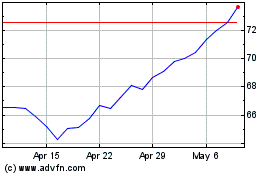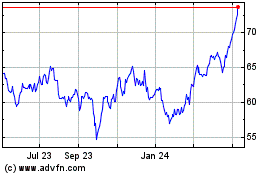Weak Natural Gas Prices Set To Lower Winter Heating Costs
October 18 2011 - 4:48PM
Dow Jones News
High gasoline prices have weighed on household budgets this
year, but relief from energy costs should arrive, surprisingly,
when temperatures start to tumble this winter.
Natural gas, used to heat nearly half of U.S. homes, is expected
to hit some of the lowest winter prices in years as rising
production and a mild autumn send U.S. stockpiles of the fuel to
record levels.
Normally, natural-gas prices surge beginning in December as cold
blankets the U.S. and residents raise their thermostats. But the
supply glut is pushing down futures prices throughout the winter,
and utilities have responded by locking in low prices that they can
pass on to consumers and, in some cases, are cutting rates.
Natural gas futures for November delivery settled 3.7% lower at
$3.553 a million British thermal units Tuesday on the New York
Mercantile Exchange, near 11-month lows. But futures contracts that
provide gas delivery in January, which would likely be use by
utilities to hedge winter demand, offer an even better bargain.
Nymex futures for January 2012, settled at $3.927/MMBtu Tuesday,
well below the key $4/MMBtu level. While this is higher than the
current front-month price, it was the lowest January settlement
since 2002 for this time in October.
"These are extremely low prices for this stuff," said John
Woods, a natural gas trader at JJ Woods Associates.
New Jersey utility Public Service Electric and Gas, a subsidiary
of Public Service Enterprise Group Inc. (PEG), lowered its
natural-gas rates by 1.3% beginning Oct. 1. National Grid projects
lower natural-gas heating costs this winter due to the recent price
declines. So is Consolidated Edison Inc. (ED), which supplies
energy to 1.1 million residents in New York.
ConEd said Tuesday it expects average residential gas-heating
bills this winter to fall by 3.8% from last year. The drop comes
despite a rate increase, and should lower the average monthly
heating bill this winter to $350 a month.
ConEd spreads its gas purchases and hedging throughout the year.
Roughly 40% of winter supplies are already in storage, much of it
at the relatively low prices seen this summer. The regulated
utility also hedges as much as 15% of its supply using the futures
market. With most of those hedges already in place, ConEd has
locked in some of the lowest prices in years.
"We've formed up a good portion of the supply at favorable
prices," said Joseph Oates, ConEd vice president of energy
management.
An "Indian summer" of mild weather through October raised
natural gas storage levels to 3.521 trillion cubic feet last week,
close to record levels. Another massive increase is expected
Thursday, suggesting there will be plenty of the fuel as heating
demand rises.
The U.S. this year is experiencing the return of the La Nina
weather pattern, which is a cooling of Pacific Ocean temperatures.
La Nina typically raises temperatures in the northern half of the
U.S. and lowers them in the south, says Dan Leonard, senior
meteorologist with Weather Services International.
"We really expect that we should continue to see it for the next
month or so," Leonard said.
Winter prices near $4 would mark a low point for domestic
producers struggling under the influx of shale gas from booming
fields in Pennsylvania, North Dakota and other regions of the U.S.
The controversial hydraulic fracturing drilling process has rapidly
increased domestic gas supplies, and utilities, producers and
traders are still scrambling to adjust to the changes.
"The old expectation was to see a substantial rise, a 30%-50%
rise, in the winter" for prices, says Ben Schelisinger, president
of BSA Energy, which advises companies on the natural gas market.
"Given what's been going on in the last 18 months, the history has
really has gone out the window."
-By Jerry A. DiColo, Dow Jones Newswires; 212-416-2155;
jerry.dicolo@dowjones.com
Public Service Enterprise (NYSE:PEG)
Historical Stock Chart
From May 2024 to Jun 2024

Public Service Enterprise (NYSE:PEG)
Historical Stock Chart
From Jun 2023 to Jun 2024
